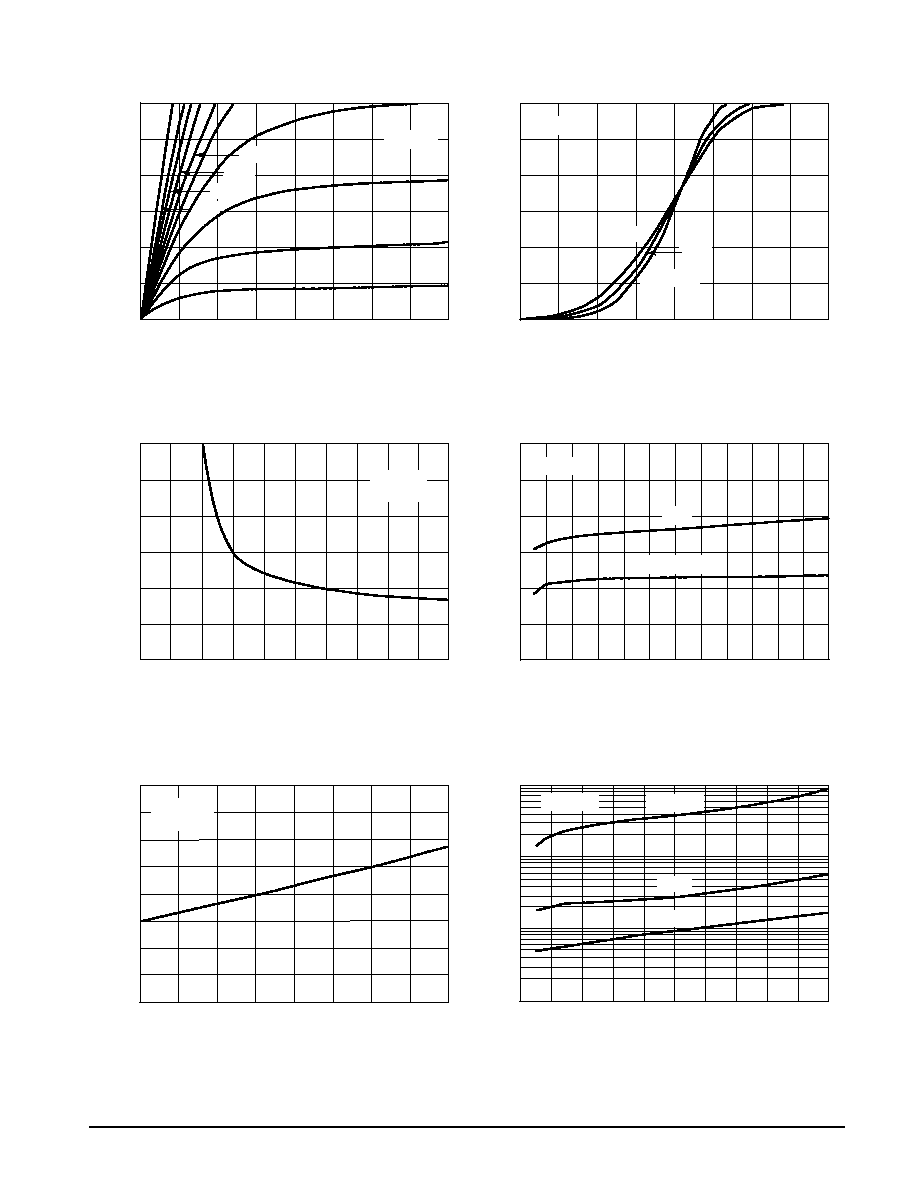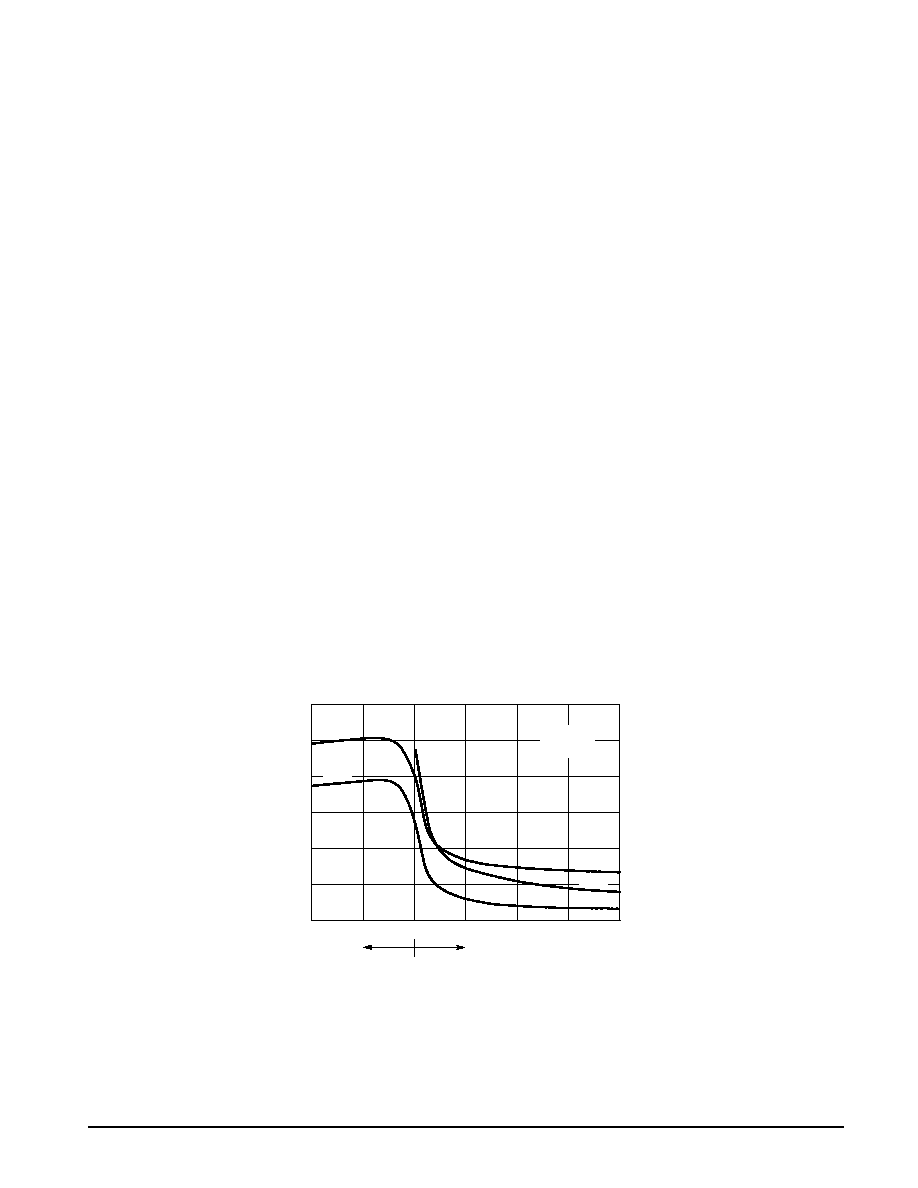
1
Motorola TMOS Power MOSFET Transistor Device Data
Designer's
TM
Data Sheet
Medium Power Surface Mount Products
TMOS Single P-Channel
Field Effect Transistors
MiniMOS
TM
devices are an advanced series of power MOSFETs
which utilize Motorola's High Cell Density HDTMOS process. These
miniature surface mount MOSFETs feature ultra low RDS(on) and true
logic level performance. They are capable of withstanding high energy in
the avalanche and commutation modes and the draintosource diode
has a very low reverse recovery time. MiniMOS devices are designed for
use in low voltage, high speed switching applications where power
efficiency is important. Typical applications are dcdc converters, and
power management in portable and battery powered products such as
computers, printers, cellular and cordless phones. They can also be
used for low voltage motor controls in mass storage products such as
disk drives and tape drives. The avalanche energy is specified to
eliminate the guesswork in designs where inductive loads are switched
and offer additional safety margin against unexpected voltage transients.
·
Ultra Low RDS(on) Provides Higher Efficiency and Extends Battery Life
·
Logic Level Gate Drive -- Can Be Driven by Logic ICs
·
Miniature SO8 Surface Mount Package -- Saves Board Space
·
Diode Is Characterized for Use In Bridge Circuits
·
Diode Exhibits High Speed, With Soft Recovery
·
IDSS Specified at Elevated Temperature
·
Avalanche Energy Specified
·
Mounting Information for SO8 Package Provided
DEVICE MARKING
ORDERING INFORMATION
S5P02H
Device
Reel Size
Tape Width
Quantity
S5P02H
MMSF5P02HDR2
13
12 mm embossed tape
4000 units
Designer's Data for "Worst Case" Conditions -- The Designer's Data Sheet permits the design of most circuits entirely from the information presented. SOA Limit
curves -- representing boundaries on device characteristics -- are given to facilitate "worst case" design.
HDTMOS and MiniMOS are trademarks of Motorola, Inc. TMOS is a registered trademark of Motorola, Inc.
Preferred devices are Motorola recommended choices for future use and best overall value.
Order this document
by MMSF5P02HD/D
MOTOROLA
SEMICONDUCTOR TECHNICAL DATA
©
Motorola, Inc. 1997
CASE 75105, Style 13
SO8
MMSF5P02HD
SINGLE TMOS
POWER MOSFET
8.7 AMPERES
20 VOLTS
RDS(on) = 0.03 OHM
Motorola Preferred Device
TM
Source
1
2
3
4
8
7
6
5
Top View
Source
Source
Gate
Drain
Drain
Drain
Drain
D
S
G
REV 2

MMSF5P02HD
2
Motorola TMOS Power MOSFET Transistor Device Data
MAXIMUM RATINGS
(TJ = 25
°
C unless otherwise noted)
Negative sign for PChannel devices omitted for clarity
Rating
Symbol
Max
Unit
DraintoSource Voltage
VDSS
20
V
DraintoGate Voltage (RGS = 1.0 M
)
VDGR
20
V
GatetoSource Voltage -- Continuous
VGS
±
8.0
V
1 inch SQ.
FR4 or G10 PCB
10 seconds
Thermal Resistance -- Junction to Ambient
Total Power Dissipation @ TA = 25
°
C
Linear Derating Factor
Drain Current -- Continuous @ TA = 25
°
C
Continuous @ TA = 70
°
C
Pulsed Drain Current (1)
RTHJA
PD
ID
ID
IDM
50
2.5
20
8.7
7.0
43.5
°
C/W
Watts
mW/
°
C
A
A
A
Minimum
FR4 or G10 PCB
10 seconds
Thermal Resistance -- Junction to Ambient
Total Power Dissipation @ TA = 25
°
C
Linear Derating Factor
Drain Current -- Continuous @ TA = 25
°
C
Continuous @ TA = 70
°
C
Pulsed Drain Current (1)
RTHJA
PD
ID
ID
IDM
80
1.56
12.5
6.9
5.5
35
°
C/W
Watts
mW/
°
C
A
A
A
Operating and Storage Temperature Range
TJ, Tstg
55 to 150
°
C
Single Pulse DraintoSource Avalanche Energy -- Starting TJ = 25
°
C
(VDD = 20 Vdc, VGS = 4.5 Vdc, Peak IL = 19 Apk, L = 5.5 mH, RG = 25
W
)
EAS
1000
mJ
(1) Repetitive rating; pulse width limited by maximum junction temperature.

MMSF5P02HD
3
Motorola TMOS Power MOSFET Transistor Device Data
ELECTRICAL CHARACTERISTICS
(TC = 25
°
C unless otherwise noted)
Characteristic
Symbol
Min
Typ
Max
Unit
OFF CHARACTERISTICS
DraintoSource Breakdown Voltage
(Cpk
2.0)
(1) (3)
(VGS = 0 Vdc, ID = 0.25 mAdc)
Temperature Coefficient (Positive)
V(BR)DSS
20
--
--
10
--
--
Vdc
mV/
°
C
Zero Gate Voltage Drain Current
(VDS = 16 Vdc, VGS = 0 Vdc)
(VDS = 16 Vdc, VGS = 0 Vdc, TJ = 125
°
C)
IDSS
--
--
--
--
1.0
25
µ
Adc
GateBody Leakage Current (VGS =
±
8.0 Vdc, VDS = 0)
IGSS
--
--
100
nAdc
ON CHARACTERISTICS(1)
Gate Threshold Voltage
(Cpk
2.0)
(1) (3)
(VDS = VGS, ID = 0.25 mAdc)
Threshold Temperature Coefficient (Negative)
VGS(th)
0.7
--
0.9
2.6
1.4
--
Vdc
mV/
°
C
Static DraintoSource OnResistance
(Cpk
2.0)
(1) (3)
(VGS = 4.5 Vdc, ID = 6.4 Adc)
(VGS = 2.5 Vdc, ID = 5.1 Adc)
RDS(on)
--
--
22
35
30
45
m
OnState Drain Current
(VDS
5.0 V, VGS = 4.5 V)
(VDS
5.0 V, VGS = 2.5 V)
ID(on)
10
5.0
--
--
--
--
A
Forward Transconductance (VDS = 9.0 Vdc, ID = 6.4 Adc)
(1)
gFS
14
18
--
Mhos
DYNAMIC CHARACTERISTICS
Input Capacitance
(V
16 Vdc V
0 Vdc
Ciss
--
1400
1960
pF
Output Capacitance
(VDS = 16 Vdc, VGS = 0 Vdc,
f = 1.0 MHz)
Coss
--
925
1300
Transfer Capacitance
f = 1.0 MHz)
Crss
--
370
520
SWITCHING CHARACTERISTICS(2)
TurnOn Delay Time
(V
6 0 Vd
I
1 0 Ad
td(on)
--
19
40
ns
Rise Time
(VDD = 6.0 Vdc, ID = 1.0 Adc,
VGS = 4 5 Vdc
tr
--
28
55
TurnOff Delay Time
VGS = 4.5 Vdc,
RG = 6.0
) (1)
td(off)
--
130
200
Fall Time
G
) ( )
tf
--
90
150
Gate Charge
See Figure 8
(V
6 0 Vd
I
6 4 Ad
QT
--
27.3
38
nC
See Figure 8
(VDS = 6.0 Vdc, ID = 6.4 Adc,
Q1
--
3.4
--
( DS
, D
,
VGS = 4.5 Vdc) (1)
Q2
--
12
--
Q3
--
8.0
--
SOURCEDRAIN DIODE CHARACTERISTICS
Forward OnVoltage(1)
(IS = 2.5 Adc, VGS = 0 Vdc) (1)
(IS = 2.5 Adc, VGS = 0 Vdc, TJ = 125
°
C)
VSD
--
--
0.77
0.6
1.2
--
Vdc
Reverse Recovery Time
See Figure 15
(I
2 5 Ad
V
0 Vd
trr
--
95
180
ns
See Figure 15
(IS = 2.5 Adc, VGS = 0 Vdc,
ta
--
35
--
( S
,
GS
,
dIS/dt = 100 A/
µ
s) (1)
tb
--
60
--
Reverse Recovery Stored Charge
QRR
--
0.151
--
µ
C
(1) Pulse Test: Pulse Width
300
µ
s, Duty Cycle
2%.
(2) Switching characteristics are independent of operating junction temperature.
(3) Reflects typical values.
Cpk =
Max limit Typ
3 x SIGMA
(4) Repetitive rating; pulse width limited by maximum junction temperature.

MMSF5P02HD
4
Motorola TMOS Power MOSFET Transistor Device Data
TYPICAL ELECTRICAL CHARACTERISTICS
VGS =
8
Figure 1. OnRegion Characteristics
Figure 2. Transfer Characteristics
Figure 3. OnResistance versus Drain Current
Figure 4. OnResistance versus Drain Current
and Gate Voltage
Figure 5. OnResistance Variation with
Temperature
Figure 6. DraintoSource Leakage Current
versus Voltage
2.0
0
VDS, DRAINTOSOURCE VOLTAGE (VOLTS)
12
8.0
10
6.0
VGS, GATETOSOURCE VOLTAGE (VOLTS)
3.0
1.0
4.0
2.0
0
0
VGS, GATETOSOURCE (VOLTS)
0.06
0.04
0.02
0
ID, DRAIN CURRENT (AMPS)
2.0
0
0.04
0.02
0
4.0
25
25
50
TJ, JUNCTION TEMPERATURE (
°
C)
2.0
1.5
1.0
0.5
0
VDS, DRAINTOSOURCE VOLTAGE (VOLTS)
4.0
0
1000
100
10
1.0
16
0
I D
, DRAIN CURRENT
(AMPS)
I
(W)
, DRAINT
OSOURCE
RESIST
ANCE
(OHMS)
R
DS(on)
, DRAINT
OSOURCE
RESIST
ANCE
(OHMS)
0
0.5
1.0
1.5
2.5
1.5
2.0
6.0
12
2.0
4.0
6.0
8.0
10
6.0
8.0
, DRAINT
OSOURCE
RESIST
ANCE
R
DS(on)
50
100
75
8.0
12
20
I DSS
, LEAKAGE (nA)
, DRAIN CURRENT
(AMPS)
D
R
DS(on)
125
150
(NORMALIZED)
TJ = 25
°
C
VGS = 4.5 V
2.5 V
VGS = 4.5 V
ID = 5.1 A
25
°
C
100
°
C
TJ = 125
°
C
VGS = 0 V
ID = 6.4 A
TJ = 25
°
C
TJ = 55
°
C
100
°
C
25
°
C
VDS
10 V
1.7 V
1.9 V
2.1 V
2.3 V
TJ = 25
°
C
2.5 V
2.7 V
3.1 V
4.5 V
3.7 V
0.06
10
12
8.0
10
4.0
2.0

MMSF5P02HD
5
Motorola TMOS Power MOSFET Transistor Device Data
POWER MOSFET SWITCHING
Switching behavior is most easily modeled and predicted
by recognizing that the power MOSFET is charge controlled.
The lengths of various switching intervals (
t) are deter-
mined by how fast the FET input capacitance can be charged
by current from the generator.
The published capacitance data is difficult to use for calculat-
ing rise and fall because draingate capacitance varies
greatly with applied voltage. Accordingly, gate charge data is
used. In most cases, a satisfactory estimate of average input
current (IG(AV)) can be made from a rudimentary analysis of
the drive circuit so that
t = Q/IG(AV)
During the rise and fall time interval when switching a resis-
tive load, VGS remains virtually constant at a level known as
the plateau voltage, VSGP. Therefore, rise and fall times may
be approximated by the following:
tr = Q2 x RG/(VGG VGSP)
tf = Q2 x RG/VGSP
where
VGG = the gate drive voltage, which varies from zero to VGG
RG = the gate drive resistance
and Q2 and VGSP are read from the gate charge curve.
During the turnon and turnoff delay times, gate current is
not constant. The simplest calculation uses appropriate val-
ues from the capacitance curves in a standard equation for
voltage change in an RC network. The equations are:
td(on) = RG Ciss In [VGG/(VGG VGSP)]
td(off) = RG Ciss In (VGG/VGSP)
The capacitance (Ciss) is read from the capacitance curve at
a voltage corresponding to the offstate condition when cal-
culating td(on) and is read at a voltage corresponding to the
onstate when calculating td(off).
At high switching speeds, parasitic circuit elements com-
plicate the analysis. The inductance of the MOSFET source
lead, inside the package and in the circuit wiring which is
common to both the drain and gate current paths, produces a
voltage at the source which reduces the gate drive current.
The voltage is determined by Ldi/dt, but since di/dt is a func-
tion of drain current, the mathematical solution is complex.
The MOSFET output capacitance also complicates the
mathematics. And finally, MOSFETs have finite internal gate
resistance which effectively adds to the resistance of the
driving source, but the internal resistance is difficult to mea-
sure and, consequently, is not specified.
The resistive switching time variation versus gate resis-
tance (Figure 9) shows how typical switching performance is
affected by the parasitic circuit elements. If the parasitics
were not present, the slope of the curves would maintain a
value of unity regardless of the switching speed. The circuit
used to obtain the data is constructed to minimize common
inductance in the drain and gate circuit loops and is believed
readily achievable with board mounted components. Most
power electronic loads are inductive; the data in the figure is
taken with a resistive load, which approximates an optimally
snubbed inductive load. Power MOSFETs may be safely op-
erated into an inductive load; however, snubbing reduces
switching losses.
Figure 7. Capacitance Variation
10
20
10
VDS, DRAINTOSOURCE VOLTAGE (VOLTS)
6000
4000
C, CAP
ACIT
ANCE
(pF)
2000
0
0
Ciss
Ciss
Crss
Crss
Coss
TJ = 25
°
C
VGS = 0 V
VGS
VDS




